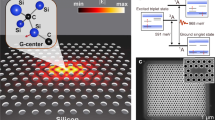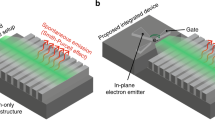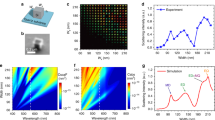Abstract
To address the limitations in device speed and performance in silicon-based electronics, there have been extensive studies on silicon optoelectronics with a view to achieving ultrafast optical data processing1,2,3. The biggest challenge has been to develop an efficient silicon-based light source, because the indirect bandgap of silicon gives rise to extremely low emission efficiencies. Although light emission in quantum-confined silicon at sub-10 nm length scales has been demonstrated4,5,6,7, there are difficulties in integrating quantum structures with conventional electronics8,9. It is desirable to develop new concepts to obtain emission from silicon at length scales compatible with current electronic devices (20–100 nm), which therefore do not utilize quantum-confinement effects. Here, we demonstrate an entirely new method to achieve bright visible light emission in ‘bulk-sized’ silicon coupled with plasmon nanocavities at room temperature, from non-thermalized carrier recombination. The highly enhanced emission (internal quantum efficiency of >1%) in plasmonic silicon, together with its size compatibility with current silicon electronics, provides new avenues for developing monolithically integrated light sources on conventional microchips.
This is a preview of subscription content, access via your institution
Access options
Subscribe to this journal
Receive 12 print issues and online access
$209.00 per year
only $17.42 per issue
Buy this article
- Purchase on Springer Link
- Instant access to full article PDF
Prices may be subject to local taxes which are calculated during checkout



Similar content being viewed by others
References
Xu, Q., Schmidt, B., Pradhan, S. & Lipson, M. Micrometre-scale silicon electro-optic modulator. Nature 435, 325–327 (2005).
Liang, D. & Bowers, J. E. Recent progress in lasers on silicon. Nature Photon. 4, 511–517 (2010).
Fan, L. et al. An all-silicon passive optical diode. Science 335, 447–450 (2012).
Cullis, A. G. & Canham, L. T. Visible light emission due to quantum size effects in highly porous crystalline silicon. Nature 353, 335–338 (1991).
Wilson, W. L., Szajowski, P. F. & Brus, L. E. Quantum confinement in size-selected, surface-oxidized silicon nanocrystals. Science 262, 1242–1244 (1993).
Brongersma, M. L. et al. Tuning the emission wavelength of Si nanocrystals in SiO2 by oxidation. Appl. Phys. Lett. 72, 2577–2579 (1998).
Walavalkar, S. S. et al. Tunable visible and near-IR emission from sub-10 nm etched single-crystal Si nanopillars. Nano Lett. 10, 4423–4428 (2010).
Park, N. M., Kim, T. S. & Park, S. J. Band gap engineering of amorphous silicon quantum dots for light-emitting diodes. Appl. Phys. Lett. 78, 2575–2577 (2001).
Walters, R. J., Bourianoff, G. I. & Atwater, H. A. Field-effect electroluminescence in silicon nanocrystals. Nature Mater. 4, 143–146 (2005).
Schmidt, P., Berndt, R. & Vexler, M. I. Ultraviolet light emission from Si in a scanning tunneling microscope. Phys. Rev. Lett. 99, 246103 (2007).
De Boer, W. D. A. M. et al. Red spectral shift and enhanced quantum efficiency in phonon-free photoluminescence from silicon nanocrystals. Nature Nanotech. 5, 878–884 (2010).
Goldman, J. R. & Prybyla, J. A. Ultrafast dynamics of laser-excited electron distributions in silicon. Phys. Rev. Lett. 72, 1364–1367 (1994).
Sabbah, A. J. & Riffe, D. M. Femtosecond pump–probe reflectivity study of silicon carrier dynamics. Phys. Rev. B 66, 165217 (2002).
Prokofiev, A. A. et al. Direct bandgap optical transitions in Si nanocrystals. JETP Lett. 90, 758–762 (2009).
Fujita, M., Tanaka, Y. & Noda, S. Light emission from silicon in photonic crystal nanocavity. IEEE J. Sel. Top. Quantum Electron. 14, 1090–1097 (2008).
Lo Savio, R. et al. Room-temperature emission at telecom wavelengths from silicon photonic crystal nanocavities. Appl. Phys. Lett. 98, 201106 (2011).
Cho, C. H. et al. Tailoring hot-exciton emission and lifetimes in semiconducting nanowires via whispering-gallery nanocavity plasmons. Nature Mater. 10, 669–675 (2011).
Purcell, E. M. Spontaneous emission probabilities at radio frequencies. Phys. Rev. 69, 681 (1946).
Ryu, H. Y. & Notomi, M. Enhancement of spontaneous emission from the resonant modes of a photonic crystal slab single-defect cavity. Opt. Lett. 28, 2390–2392 (2003).
Baba, T. & Sano, D. Low-threshold lasing and Purcell effect in microdisk lasers at room temperature. IEEE J. Sel. Top. Quantum Electron. 9, 1340–1346 (2003).
Englund, D. et al. Controlling the spontaneous emission rate of single quantum dots in a two-dimensional photonic crystal. Phys. Rev. Lett. 95, 013904 (2005).
Barnes, W. L., Dereux, A. & Ebbesen, T. W. Surface plasmon subwavelength optics. Nature 424, 824–830 (2003).
Kittel, C. Introduction to Solid State Physics 106–129 (Wiley, 2005).
Wei, S. & Chou, M. Y. Phonon dispersion of silicon and germanium from first-principles calculations. Phys. Rev. B 50, 2221–2226 (1994).
Chelikowsky, J. R. & Cohen, M. L. Electronic structure of silicon. Phys. Rev. B 10, 5095–5107 (1974).
Racek, W., Bauer, G. & Kahlert, H. Dynamic measurement of hot-electron magnetophonon effect in n-InSb at 11 K. Phys. Rev. Lett. 31, 301–304 (1973).
Temple, P. A. & Hathaway, C. E. Multiphonon Raman spectrum of silicon. Phys. Rev. B 7, 3685–3697 (1973).
Andreani, L. C., Panzarini, G. & Gérard, J. M. Strong-coupling regime for quantum boxes in pillar microcavities: theory. Phys. Rev. B 60, 13276–13279 (1999).
Johnson, P. B. & Christy, R. W. Optical constants of noble metals. Phys. Rev. B 6, 4370–4379 (1972).
Palik, E. D. Handbook of Optical Constants of Solids (Academic, 1998).
Acknowledgements
This work was supported by the US Army Research Office (grant nos W911NF-09-1-0477 and W911NF-11-1-0024) and the National Institutes of Health through the NIH Director's New Innovator Award Program (1-DP2-7251-01). C.O.A. is supported by the US Department of Defense, Air Force Office of Scientific Research, National Defense Science and Engineering Graduate (NDSEG) Fellowship. The authors thank A. Boukai (Michigan) and J. Spanier (Drexel) for providing vapour-liquid-solid (VLS)-grown silicon nanowire substrates.
Author information
Authors and Affiliations
Contributions
C-H.C. and R.A. developed the concept and design of the devices. C-H.C. fabricated the devices and performed optical measurements. C.O.A. performed the numerical simulations, fabricated devices and performed optical measurements at 532 nm excitation. J.P. fabricated and carried out the emission experiments on bowtie structures. C-H.C., C.O.A. and R.A. analysed the results and wrote the manuscript.
Corresponding author
Ethics declarations
Competing interests
The authors declare no competing financial interests.
Supplementary information
Supplementary information
Supplementary information (PDF 3878 kb)
Rights and permissions
About this article
Cite this article
Cho, CH., Aspetti, C., Park, J. et al. Silicon coupled with plasmon nanocavities generates bright visible hot luminescence. Nature Photon 7, 285–289 (2013). https://doi.org/10.1038/nphoton.2013.25
Received:
Accepted:
Published:
Issue Date:
DOI: https://doi.org/10.1038/nphoton.2013.25
This article is cited by
-
Hyperbolic whispering-gallery phonon polaritons in boron nitride nanotubes
Nature Nanotechnology (2023)
-
Highly efficient nonlinear optical emission from a subwavelength crystalline silicon cuboid mediated by supercavity mode
Nature Communications (2022)
-
Quasiadiabatic electron transport in room temperature nanoelectronic devices induced by hot-phonon bottleneck
Nature Communications (2021)
-
Recent progress in periodic patterning fabricated by self-assembly of colloidal spheres for optical applications
Science China Materials (2020)
-
Nanophotonic engineering of far-field thermal emitters
Nature Materials (2019)



